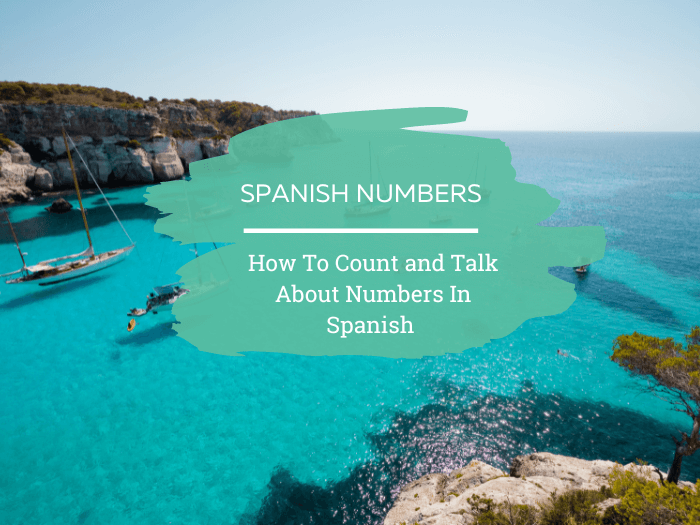When you learn Spanish or any other language, one of the first things you learn is how to count to 10.
In fact, counting is one of the first things most of us learn in our native language as well. That's because being able to use numbers is a vital part of describing our lives and world.
The same concept is true when you are learning a second or third language. Pretty early on in the process, you will want to be able to use numbers in conjunction with the words you are learning to specify how many of something you have, need, or see.
Numbers are also useful in telling time and giving specific dates—all things you will want to be able to do as you immerse yourself in this new language.
Before we jump in with the actual Spanish numbers from 1 to 100 and beyond, it will help to know a little bit about the different kinds of numbers used in English so that you have the right understanding moving forward.
By the way, if you're getting started in Spanish and want to go from beginner to intermediate fast, I recommend Spanish Uncovered. It's my story-based course that will get you to conversational fluency fast, without getting bogged down in grammar.
Why Should You Learn Spanish Numbers?
Learning Spanish numbers is a crucial part of your language learning process. Without the numbers, getting by with day-to-day life in Spanish speaking countries will be a struggle.
There are plenty of reasons you should learn Spanish counting when you first start with the language. Check out a few reasons below:
1. Ease Of Communication
Learning Spanish numbers is essential if you want to communicate with ease and reach fluency quicker.
When you know the numbers, you can speak about time, age, prices, dates, and quantities – all part of everyday life conversation.
2. Shopping And Money
Knowing the price of something you want to buy in a Spanish-speaking country is one of the very basics you need to know. If you can ask a price and understand it, you are less likely to get ripped off and show confidence in the language.
3. Telling The Time
Another crucial aspect of Spanish speaking is knowing how to write the time in Spanish and how to tell the time. You'll have way less confusion when communicating in the language if you can tell the time.
4. Cultural Awareness
If you master the Spanish numbers, you'll get a better insight into the Spanish-speaking world and common communication patterns. You will discover there are a lot of differences from the English-speaking world.
5. Travel And Transportation
If you want to get around and use public transport when abroad, you'll need to know the Spanish numbers. You don't want to miss your bus because you mixed up cincuenta and cinco, now do you?!
6. Dates And Calendar
Another important reason to get to grips with the Spanish numbers is to make sure you can schedule appointments on the right day at the right time! If you want to get into the swing of speaking Spanish, being able to organise your schedule in the language is one of the first steps.
Learn how to write dates in Spanish and you'll never make a mistake again.
7. Phone Numbers
If you travel or move to a country where Spanish is the main language, you'll need to ask for people's phone numbers.
Whether it's someone you want to become friends with, your local hairdresser, or a potential date, how will you get the number without knowing the numbers?! Mastering the numbers in Spanish will save you from any awkward situations with a native speaker.
8. Ordering In A Restaurant
Want to order your favourite meal for you and a friend? You'll need to know numbers in Spanish so as to avoid any embarrassing mishaps!
9. Increased Confidence In the Language
When learning Spanish, the numbers are some of the quickest and easiest vocabulary to pick up, which will help you in all sorts of situations. If you know your numbers, it will give you the confidence to engage in conversation with native speakers and be ready to interpret their answers.
10. Boost Your Cognitive Skills
Committing to learning numbers is a great way to ease into language learning, improve your memory skills, and exercise your brain. If you learn the correct Spanish pronunciation for the numbers and how to write numbers in Spanish, you'll give your brain a workout and keep yourself motivated to learn more.
11. Boost Your Overall Proficiency
Learning a language without numbers would be a strange thing to do! So mastering the numbers early on is a great way to boost your overall fluency and grasp the correct pronunciation and grammatical rules used for Spanish numerals.
Facts About Spanish Numbers
Before we get into the nitty-gritty of how to count to 10 in Spanish, here are some fun facts about Spanish numbers that you can use to impress your fellow language learners!
1. Word Roots
The Spanish word for “zero” – cero – comes from the Arabic word “sifr” which is also the root of the English word “cipher”.
2. An Unlucky Number
As in many cultures around the world, the number 13 is considered unlucky in Spanish.
3. And A Lucky One
Number 15 is often considered lucky by Spanish-speaking people and bingo players refer to the number as la niña bonita (the beautiful girl).
4. Don't Confuse Your Millions And Billions
The higher numbers in Spanish can be confusing for English speakers – for example mil milliones (one thousand millions) means a billion and bilión means a trillion.
5. I Have, Not I Am
When you talk about age in Spanish, you use the verb tener “to have”. For example, tengo trenta y uno años.
6. Gendered Numbers
Spanish numbers have to agree with the gender of the noun they are describing, for example – uno is used for a masculine noun and changes to una when describing a feminine noun.
7. Similarities To Italian
Don't get your Spanish numbers mixed up with the Italian numbers! The two languages have a lexical similarity of 82% and the numbers are very similar in both languages.
Cardinal vs. Nominal vs. Ordinal Numbers
As with English, Spanish has both “cardinal,” “nominal” and “ordinal” numbers (numeros cardinales, nominales y ordinales).
While you probably won't need to know the names of number types in your day-to-day conversations, it can be helpful to understand the difference as you learn how to use Spanish numbers.
Cardinal numbers are numbers that describe quantity. In other words, numbers that can answer the question “How many?”:
- Ana tiene dos hermanos. (Anna has two brothers.)
- Tengo un gato. (I have a cat.)
- Hay siete casas en nuestroa calle. (There are seven houses on our street.)
- Tengo treinta y cinco años. (I am thirty-five years old.)
Nominal numbers don't actually represent a quantity or measurement of any kind. Instead, nominal numbers are used on their own as a name or category. (You probably recognized that the “nom–” beginning of the word is very similar to “nombre.”)
- El numero ocho metió el gol. (Number eight scored the goal.)
- Su número de teléfono es 83683. (Their telephone number is 83683.)
Ordinal numbers in Spanish are the numbers used to put things in orders or ranks:
- En dos meses, celebraremos nuestro tercer aniversario de bodas. (In two months, we will celebrate our third wedding anniversary.)
- Juanito está en el décimo grado. (Juanito is in tenth grade.)
- El equipo quiere ganar el primer lugar. (The team wants to win first place.)
In Spanish (as in English), cardinal and nominal numbers use the same word (for example, “one” or “nine”), whereas numbers that are considered ordinal have a completely different vocabulary (“first” or “ninth”).
If you are just starting out with Spanish numbers, you'll want to start with the numbers that denote quantity. Or, in other words, the words you use when you know how to count.
Start With Spanish Numbers 0-15
In Spanish, the most important numbers to learn are the first 15. Once you can count to 15 in Spanish, you will be able to master the rest fairly quickly because the numbers 1-15 are the foundation for every other number.
If you glanced ahead, you may have noticed that I've actually listed 16 numbers below. Unlike numbers 1-15, zero is rarely used for anything other than itself.
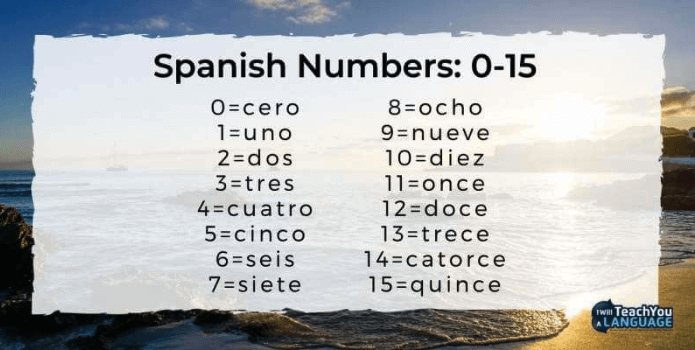
You'll still benefit from learning zero early on, however, because it is very common in everyday communication.
Although zero is regularly used as a nominal number (as part of a telephone number or address, for example) instead of denoting quantity, it's easy to learn with the rest of the first 15 numbers:
- 0 – Cero
- 1 – Uno
- 2 – Dos
- 3 – Tres
- 4 – Cuatro
- 5 – Cinco
- 6 – Seis
- 7 – Siete
- 8 – Ocho
- 9 – Nueve
- 10 – Dicz
- 11 – Once
- 12 – Doce
- 13 – Trece
- 14- Catorce
- 15 – Quince
After 15, a predictable pattern emerges that makes it very easy to learn your numbers all the way up to 99.
Use The Natural Pattern In Spanish To Master Numbers 16-99
After the number 19, with the English words we start constructing numbers with two parts: the tens value and the ones value.
For example, 20-29 all start with the same first word, “twenty.” We use that same pattern up into the hundreds, thousands and more. Spanish is the same way, but the pattern begins at 16:
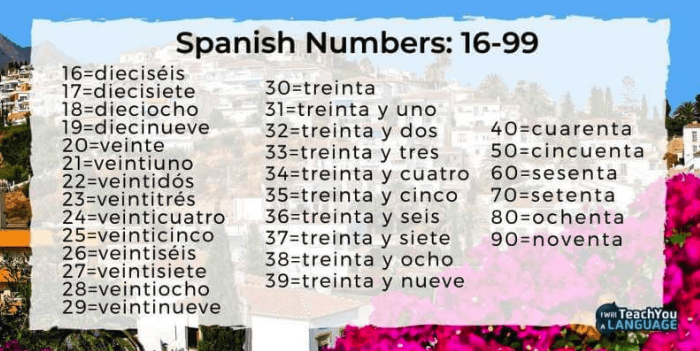
- 16 – dieciséis
- 17 – diecisiete
- 18 – dieciocho
- 19 – diecinueve
- 20 – veinte
- 21 – veintiuno
- 22 – veintidós
- 23 – veintitrés
- 24 – veinticuatro
- 25 – veinticinco
- 26 – veintiséis
- 27 – veintisiete
- 28 – veintiocho
- 29 – veintinueve
- 30 – treinta
- 31 – treinta y uno
- 32 – treinta y dos
- 33 – treinta y tres
- 34 – treinta y cuatro
- 35 – treinta y cinco
- 36 – treinta y seis
- 37 – treinta y site
- 38 – treinta y ocho
- 39 – treinta y nueve
Fairly simple, right? Starting at 30, spelling numbers in Spanish actually becomes even easier. Instead of adding the two parts of the number together (veinte + dos = veintidós), you simply add “y” between the separate words.
The pronunciation is the same either way but do watch out for the difference in spelling for 16-29 for times when you have to write out the whole word or spell numbers in Spanish.
Once you have mastered the pattern, all you have left is to learn the words for 40, 50, 60, 70, 80, and 90 to be able to count all the way to 99:
- 40 – cuarenta
- 50 – cincuenta
- 60 – sesenta
- 70 – setenta
- 80 – ochenta
- 90 – noventa
That's it! For any number from 30-99, simply start with the desired tens value and tack on an y plus the ending:
- Había cuarenta y siete dentistas en la reunión. (There were forty-seven dentists at the meeting.)
As with “uno” by itself, numbers ending with uno drop the “o” before masculine singular nouns:
- Mi hermano tiene veintiún años. (My brother is 21 years old.)
How To Count To 100 In Spanish..And Beyond
Spanish numbers follow the same basic pattern after 100, with a few notable differences:
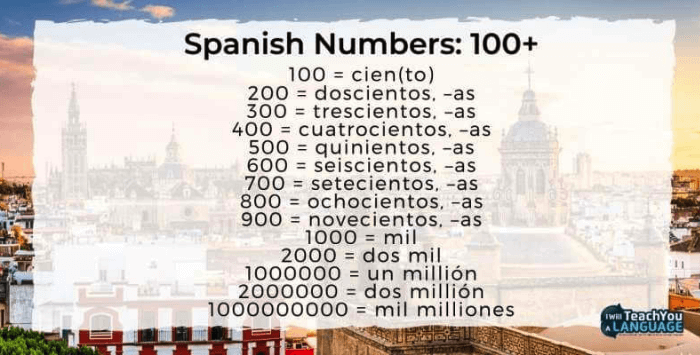
The word for 100, ciento, is shortened to cien before nouns and other numbers but keeps its full form in other uses.
Hundreds are also modified to match the gender of the noun they modify:
- Yo coincido ciento por ciento. (I agree one hundred percent.)
- En cien días desde hoy, vamos al Egipto. (One hundred days from today, we're going to Egypt.)
- La escuela tiene doscientas chicas. (The school has 200 girls.)
It is worth noting that cien is sometimes used when you would expect ciento, especially in informal Spanish.
In the case of “one hundred percent,” for example, ciento por ciento is the most proper expression, but you might hear cien por cien or even cien por ciento in your travels.
Spanish Ordinal Numbers 1-10
Once you're comfortable with the cardinal numbers, it's time to learn the ordinal numbers in Spanish. Why only 1 to 10? Starting with 11, the cardinal number is used for order/rank as well.
That means once you learn these, there are only 10 numbers left to learn:
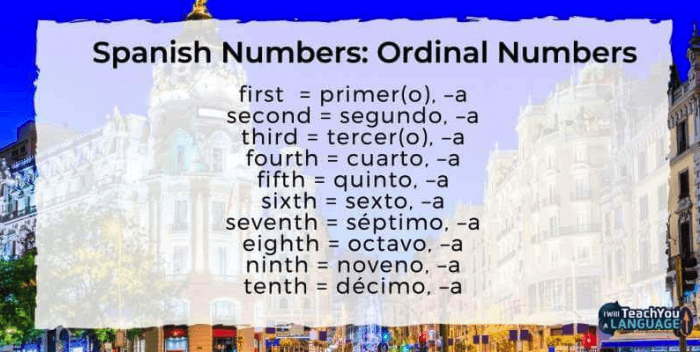
- First – Primer (o), -a
- Second – Segundo, -a
- Third – Tercer (o), -a
- Fourth – Cuarto, -a
- Fifth – Quinto, -a
- Sixth – Sexto, -a
- Seventh – Séptimo, -a
- Eighth – Octavo, -a
- Ninth – Noveno, -a
- Tenth – Décimo, -a
Ordinal numbers agree in number and gender with the nouns they modify. In the case of primero and tercero, drop the final “o” before masculine singular nouns:
- Mi primer carro fue blanco y azul. (My first car was white and blue.)
- Mira la palabra en la quinta página. (Look on the fifth page for the word.)
While there are words for ordinal numbers past 10, they are not commonly used. As you get more confident in Spanish, you can double back and learn those words if you would like. Using cardinal numbers for 12th on up is perfectly acceptable.
In a pinch, you should be able to intuit what is being said by the root of the word (“octogésimo” for “eighty,” for example) if someone uses a word you are unfamiliar with.
As in English, ordinal numbers have special abbreviations in Spanish. There is nothing wrong with writing out the words, but you should be familiar with these abbreviations so you aren't confused when you see them.
The way the number is abbreviated depends on whether the number is singular, plural, masculine, or feminine. Once you understand the pattern, however, the system is quite simple:
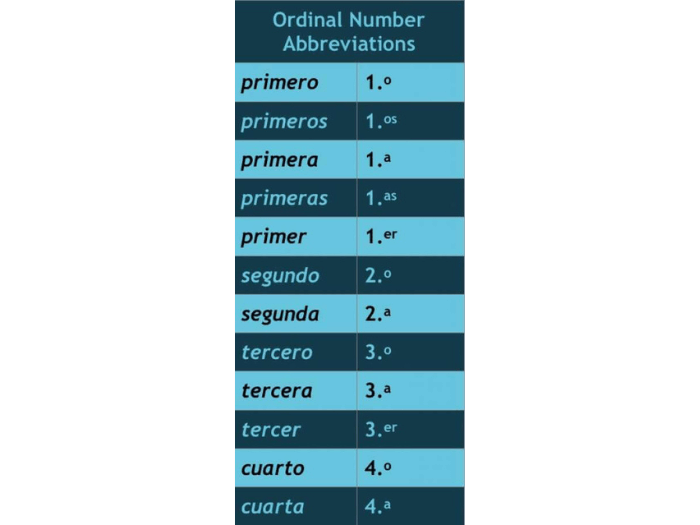
Decimal Separators In Spanish
Most Spanish-speaking countries use a decimal point to separate groups of 1000 and a period before decimals. Depending on your native language, this may be familiar to you or maybe the opposite of how you are used to separating numbers.
- Hay 2.462.378 habitantes en el país. (There are 2,462,378 people in the country.)
- El ordenador cuesta $1.879,99. (The computer costs $1,879.99)
You may find that in Latin America, the use of decimal separators is different from that in Spain. It's always good to familiarise yourself with the use of separators for the country you're in so as to avoid any unwanted mistakes!
How To Write Dates In Spanish
You can't speak Spanish without knowing how to say the day, month, and year. When writing the date in Spanish, there are a few important elements to keep in mind:
- The most common format for the date in Spanish is the day, month, year order – 15 de junio 2023
- The cardinal version of the number is used to say the date – uno, dos, tres – unlike in English which uses the ordinal version
- The definitive article comes before every date in Spanish – el 22 mayo (the 22nd of May)
- You don't need to capitalise the months in Spanish as you do in English
- It is also important to know that years are stated as cardinal numbers
- Me licenciaré en el dos mil veintidós (I will graduate in 2022)
- You can abbreviate the year to be the last two digits – veintitrés is fine to talk about the year 2023
- In Mexico, they may use the American version of the date with the month coming first
Once you know the numbers, saying the date is pretty straightforward, you just need to learn the months of the year!
Fractions In Spanish
Fractions are most commonly written with the actual number. If you need to spell out the word, however, use this table as a guide:
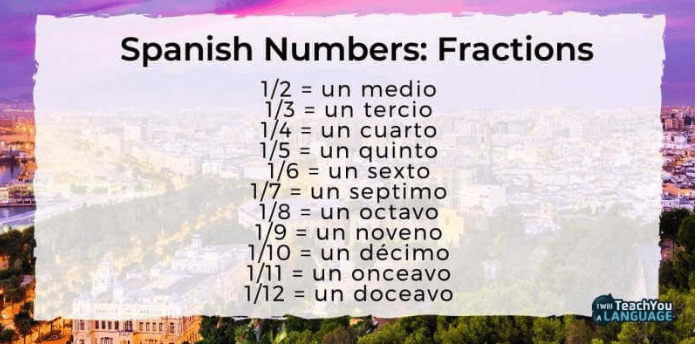
Telephone Numbers In Spanish
Telephone numbers, which are nominal, are generally given in sets of two:
- Su teléfono es el treinta y ocho, sesenta y dos, cuarenta y cinco. (Her telephone number is 38-62-45.)
For more on the subtleties of using Spanish numbers, including years and measurements, press play on the video below.
Spanish Numbers: Putting It Into Practice
Even with all the many details that go into mastering Spanish numbers, the basics are simple.
Once you've learned 0-15 and familiarised yourself with the pattern moving past 15, you will be able to express just about any number you need with the correct Spanish pronunciation.
As for the fractions, abbreviations, and ordinal versions…those come with time and practice.
With a little revision and plenty of opportunity to hear and read authentic Spanish, you can feel confident using Spanish numbers fluently yourself.
As soon as you are comfortable with 0-15, don't let fear hold you back from jumping into conversations and using numbers in your conversations. The rest will come with time, exposure, and experience!

Olly Richards
Creator of the StoryLearning® Method
Olly Richards is a renowned polyglot and language learning expert with over 15 years of experience teaching millions through his innovative StoryLearning® method. He is the creator of StoryLearning, one of the world's largest language learning blogs with 500,000+ monthly readers.
Olly has authored 30+ language learning books and courses, including the bestselling "Short Stories" series published by Teach Yourself.
When not developing new teaching methods, Richards practices what he preaches—he speaks 8 languages fluently and continues learning new ones through his own methodology.
